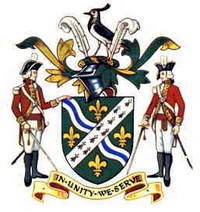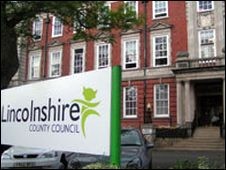|
Local
government
COUNTY
DISTRICT
& PARISH |
 |
The administration of our local
affairs dates back to the village meetings of early times and it is barely
a hundred years since the last of them, the vestry meetings, were replaced by elected councils.
Their formation, particularly the parish
council, has now become an integral part of our life yet can be traced back over the centuries through the development of
our villages in England from Saxon and Norman times.
One thousand years ago, communications were poor and central government often weak and so there was little national control. As a result, the Lord of the Manor usually ruled the villages. Eventually,
he was joined by the parish priest and sometimes the schoolmaster and
between them they established a kind of ruling clique. This was a comparatively simple task because in small villages they were likely to be the only people who could read and write. In effect these leaders in the community became the first parish
councillors, in deed if not in name.
By the early 17th century, vestry meetings were being held in the parish church after Sunday morning service, dealing with church affairs as well as looking after the old, the poor and the infirm, appointing church wardens, sextons and even village constables. Their authority became so complete that it was quite natural for legislators to give them the responsibility of levying the poor rate. These were the first effective local taxes. Everyone in the parish was entitled to attend vestry meetings but in practice, the work fell to a few individuals, rather like
parish councils of today.
Following the Poor Law Act of 1601, the payment of rates to maintain the
destitute became compulsory. Poor rates were approved by the justices and any complaints about unfair
assessments were heard at the Quarter Sessions. From the mid-17th century, parishes were also able to impose a
levy for repairs to the parish roads. Ratepayers also had to pay
a county levy, which was decided by the justices at Quarter Session, and collected locally by the constable. These included payments for the hospitals and the gaols (from 1700) while any other
monies needed for improvements to the district, such as building a road or a canal or enclosing land, could be levied once a local Act of Parliament had been passed. In the 19th century, various Acts of Parliament were
enacted to enable rates to be imposed for works which would benefit the community, without first taking the matter through Parliament, for example the Museum Act of 1845, the Baths and Wash-houses Act (1846-47), the Public Libraries Acts (1850 and 1855) and the Recreation Grounds Act (1859). District councils were formed in 1894, and were given the authority to collect rates from householders in their
jurisdiction. An Act of Parliament of 1744 gave residents the right to inspect
the accounts.
The earliest rate assessments were written into the account books kept by churchwardens and parish overseers. They usually listed the householder's name and the amount payable for his property. Later, printed books were used, listing the houses street by street, the value of the property, the householder's name and the amount assessed.
Although the 1834 Poor Law Amendment Act removed from parish vestries the responsibility for poor relief and handed it to Poor Law Unions, parishes became responsible for administering local charities. As a consequence of the 18th century Enclosure Acts, they also
took over the management of commons.
The squire, the parson and sometimes the schoolmaster, were still the leaders in the village in the late 19th century but popular education was spreading and more people wanted a say in managing local affairs and this was achieved through the 1894 Local Government Act, championed in Parliament by the Prime Minister, William Ewart Gladstone, and although it met a great deal of opposition, with over 800 amendments moved during its passage through the house, the act became law and parish councils were formed. It created institutions having civil origins, status and affiliations and transferred the civil functions of the older authorities to the new institutions. By this Act, the church and state at parish level were completely separated.
Since the 1894 Act, the vestry still meets in every parish in every county at least once a year for the election of churchwardens so perpetuating the English tradition that started 600 years ago.
But at the same time, it put the administration of our affairs at local
level in the hands of councils with elected councillors to run them.
The Act also enabled parish councils to receive their income from rates levied on
farmland. However, this was a time of agricultural depression and the money raised was so low that this system was soon abandoned and householders were then rated as an alternative. This form of taxation had never been experienced before and
this lead to some opposition to the parish councils. It was not until after the First World War of 1914-18 that central government began to give serious responsibilities to parish councils, the earliest among them being the provision of allotments and playing fields.
After the Second World War of 1939-45, the National Association of Parish Councils was formed and by 1952 half of all parishes in the country were members. The association became a national force and raised the profile and consequently the activity of parish councils to that we know today. In Bourne, our own parish council, formed in 1974, has, because of its historical significance, been given special status as a town council with the ability to elect its own mayor although this privilege is purely decorative and
it has no more authority than any other parish council. What powers it did
have, however, have been seriously eroded over the years and effective control of our local affairs now rests firmly with
the upper tiers of local government, the district and county councils.
In Bourne, the introduction of local councils in 1894 meant an end to the
vestry meetings and the formation of a rural council to administer the
country areas and a parish council for the town but the latter lasted only
five years because during that time, the authority applied to Kesteven
County Council for
urbanisation on the grounds of its population and size. A report on the
application was carried by the Lincolnshire Echo on Thursday 5th
August 1897 saying:
An application has been received from Bourne
asking the county council for an order forming the parish of Bourne into
an urban district. The General Purposes Committee were of the opinion that
a prima facie case had been made out by Bourne and unanimously recommended
the county council that a local inquiry be held. The report was accepted
and the following gentlemen were appointed to hold the inquiry at Bourne:
Alderman Sir Hugh Cholmeley, Alderman Rowe and Alderman Stapleton.
The inquiry found no reasons not to endorse
the application which was
granted by Kesteven County Council in May 1898 and came into force the
following year. The newly elected bodies subsequently met first at the Corn Exchange and then the Town Hall, although Wake House was
the venue for a period and the Red Hall occasionally.
The rural and urban councils for Bourne
were swallowed up by the newly constituted South Kesteven District Council
in 1974 as part of yet another re-organisation and so the administration of our affairs at local level now
rests with a three tier system, each authority with its own elected
councillors, although many belong to two and even all three, a massive and
unwieldy combination of bureaucratic control in the hands of an army of
local councillors and salaried officials.
| Lincolnshire County Council is in
overall control of roads, schools and libraries, the fire
brigade and the police authority, social services, museums and art
galleries, emergency planning and many other spheres of activity. The spending budget is currently £1,116 million (2009-10) and the council,
based in Lincoln, has 77
elected members, all of whom are paid through a system of allowances, and
has a workforce of more than 12,000 people making it the biggest employer in the
county. |
 |
South Kesteven District Council is
responsible for housing, waste, leisure and recreation, land use and
planning applications. The spending budget is currently £15.1 (2012-13) and the council,
based in Grantham, has 58 elected members, all of whom are paid through a system of
allowances, and employs 645 full and part time staff (2013 figure).
Bourne Town Council has limited
powers, confined to the Christmas lights, the town cemetery, street names
and similar parochial issues, but the council does have an input into all
planning matters affecting the town and its councillors are usually the
first to be approached by anyone with a problem or a complaint. The
spending
budget is currently £100,000. The council, which meets in the Town Hall, has 15 elected councillors, none
of whom are paid, and employs five people.
The county and district councils are
financed by substantial grants from central government (51% in 2009-10)
but depend for a large part of their income on business rates levied on
commercial premises (15%) and a council tax levied on domestic properties
(13%). The latter, which has the higher profile because it affects most
individuals, is banded at eight levels according to size and can therefore be as
low as £889 or as high as £2,667 (2009-10 figures). The average is
therefore Band D, £1,333.53, on which the councils make their calculations
for the ensuing year.
REVISED
SEPTEMBER 2014
See also
Vestry
meetings The Town Council
Council
chairman and mayors of Bourne since 1894
The
Council Tax - an explanation

Go to:
Main Index Villages
Index
|

